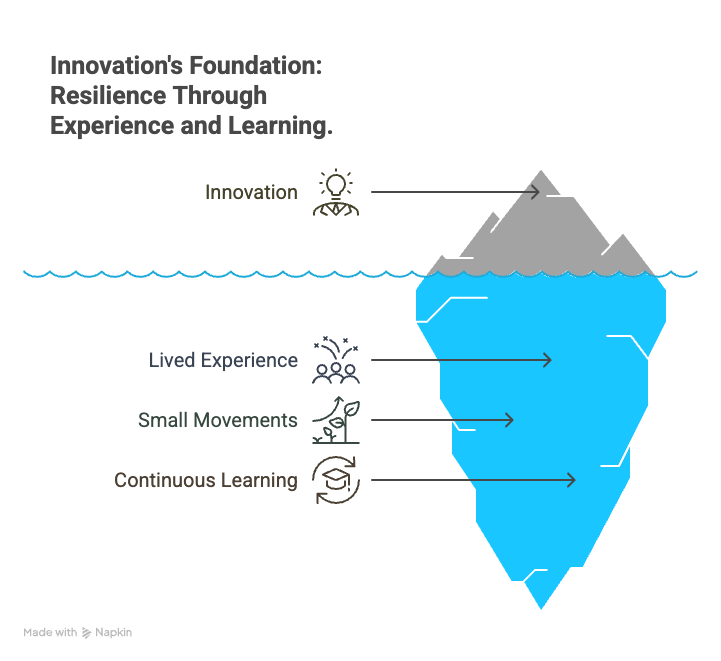What AI Can’t Build: 2 Practices for Resilient Leadership in a Changing World
Co-created with TEDx speaker and Leadership Strategist Paul Stepczak
Let’s stay connected—find me on LinkedIn and Medium to further the conversation.
This article is specially crafted for teams, organizations, and business leaders by TED Speaker Paul Stepczak and me, originally posted on LinkedIn. His TEDx talk, “8 Steps for Co-Designing with Communities,” offers a timely reminder: real resilience isn’t about pushing through, it’s about building in flexibility, creativity, and iteration.
We’re not just leading through uncertainty. We’re leading through acceleration.
The pace of change isn’t just fast, it’s exponential. AI is rewriting the rules of work, leadership, and innovation. Technology is moving faster than policies, faster than people, and often faster than wisdom can catch up.
This isn’t just happening in Silicon Valley. It’s happening in your meetings, your inbox, and your team expectations.
Leaders are being asked to make decisions with less clarity, more tools, and a rising expectation to automate what used to require discernment.
Whether you’re leading a nonprofit, a startup, a creative business, or a church team, this applies to you. Because no matter how advanced AI becomes, the strength of our leadership will still come down to how well we manage trust, change, and people.
So, how do we build teams that thrive in that kind of environment? Not just teams that adopt the right tools, but teams that stay human, curious, and resilient?
Here are two proven practices we’ve seen work again and again.
Practice 1: Share the Steering Wheel
Agility through Shared Ownership
The faster technology moves, the more tempting it is to centralize control. But bottlenecked leadership doesn’t scale, it stalls.
AI can assist decisions. But it can’t replace ownership.
When people are trusted to make meaningful contributions, they're more engaged, adaptive, and capable of navigating fast turns. This doesn't mean chaos. It means clarity and shared responsibility.
We see the same truth in AI integration: the people closest to the problem often understand the risks and nuances better than the executives making the call. That’s why co-design must include lived experience, not just technical expertise.
Try asking:
“Who else needs to lead this?”
“What’s the lightest touch I can give this, and still make sure it moves forward well?”
Innovation as a Resilience Practice
The key is staying innovative without losing your soul. Three things matter most:
Center your lived experience in every solution.
AI may handle data, but it can’t substitute insight. The best strategies start with those directly affected.Seed small movements to spark large ones.
You don’t need one viral moment. You need a pattern of small-scale, repeatable changes that grow.Make learning part of the system.
In an AI world, feedback must be continuous. We can’t afford to wait until the end to find out what’s not working.
Bottom Line: Tech doesn’t create resilience. Trust does. And shared ownership is one of its strongest forms.
Leadership Balance
But here's the balance: This doesn't mean giving away all authority. It means building enough trust to let others act, and enough clarity to keep the mission aligned.
Adam Kahane says it well in Facilitating Breakthrough:
“Move means not only to talk but to act. Forward means acting not simply to reproduce the status quo but to make things better. And together means acting not only each in one’s own way but with some degree of alignment.”
Here’s what this looks like:
Co-Design: Bring all voices into the creation process.
Co-Delivery: Share the work, the credit, and the impact.
Co-Ownership: Give people a reason to stick with it.
Without relational equity, this collapses. Equality and reciprocity are the glue.
3 Ways to Practice This Today:
Let team leads design parts of your next rollout.
Co-create strategy with your users or audience.
Use a "decision rights" map to clarify who decides what.
Practice 2: Create Space for the Unsaid and Unseen
Creativity through Inclusive Voice
If AI is trained on what’s already known, human teams must surface what’s still hidden.
Most teams don’t lack intelligence. They lack safety.
And in fast-moving environments, silence gets mistaken for agreement. But resilience dies in rooms where only the confident speak.
“Communities already hold the knowledge we need, but we have to create the safety and structure for that knowledge to surface.” — Paul Stepczak
Design your meetings and decisions to make this happen:
Use "1-2-4-All."
Start with 1 minute of silent reflection. Then:2 minutes in pairs
4 minutes in small groups
Share insights as a team
Map and use your strengths.
Ask: What human, social, public, financial, and physical assets are we underusing?Exchange diverse perspectives.
Before deciding, invite each person to describe the issue from their view.Generate at least 100 ideas.
Why? Because the best one usually isn’t the first. Then sort by feasibility, desirability, and viability.Name what’s not being said.
Assign a "vibe checker" or use this anonymous prompt: "What’s one concern or hesitation you haven’t voiced yet?"
Bottom Line: AI can mimic patterns. But only humans can hold space for what hasn’t yet been spoken.
How Can You Start Practicing This Today?
Too many teams bolt new tech onto old mindsets. Then wonder why trust erodes.
To lead well now, we need systems and habits that adapt as fast as the tools we adopt. Here are five ways to build that into your daily rhythm:
Identify root causes, not just symptoms.
Build a Theory of Change that keeps your vision central but your path flexible.
Define sustainability: Who or what holds this together over time?
Use real-time learning loops. Not just end-of-project evaluations.
Adapt intentionally: through iteration, recombination, or repurposing.
Want a practical way to apply this with AI?
Here’s a simple prompt you can use with ChatGPT to apply these ideas:
Act as a leadership strategist. Based on this draft project summary, offer insights into two key areas: 1. Shared Ownership — Where could broader collaboration, delegation, or co-creation increase collective commitment or resilience? 2. Lived Experience — Suggest one practical way to bring the wisdom of lived experience (e.g. staff, community members, or beneficiaries) into the design or decision-making process.
You can also ask your team:
"What might my team be assuming that we haven’t named?"
These aren’t just productivity hacks. They’re prompts for better leadership.
Resilience isn’t a trait. It’s a shared practice.
And in a world shaped by exponential tech, the most future-ready leaders will be the ones who keep listening, adapting, and building trust where it matters most.





Really loved this series of discussions, AI can do a lot, but it can’t build trust or presence the way people can.
Going to the fundamentals of psychology are we? Such a helpful piece on the importance of ownership and inculcating safety in the team. AI can go fast but it's ultimately down to establishing trust. I really liked the two actionable frameworks too (the 'vibe checker' idea for surfacing what's not being said is just a nice touch!) You and Paul did a fantastic job here. Thanks for sharing this with us!